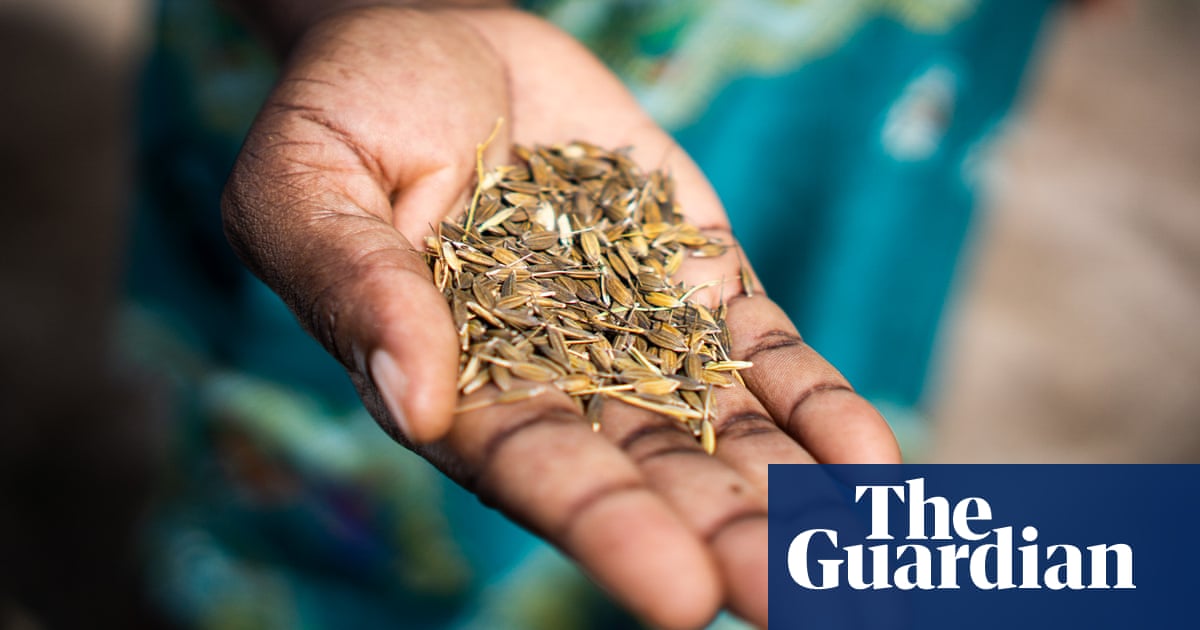How rice hidden by a woman fleeing slavery in the 1700s could help her descendants | Suriname
When enslaved Africans escaped the Surinamese plantations overseen by Dutch colonists from the 17th to the 19th century, several women ingeniously hid rice grains in their hair to grow when they found refuge deep in the Amazon rainforest. Now, centuries later, a gene bank is working to save Suriname’s rare rice species while also preparing communities to be more resilient to the climate crisis.
In Suriname’s hinterlands, near the town of Brokopondo, Albertina Adjako, a descendant of those Africans – who became known as Maroons – carefully walks in her flip-flops through her rice seedlings. “We are worried because we had a long period of drought,” she says, inspecting her plants.
As the impacts of the climate crisis are felt globally, rural farming communities are exceptionally vulnerable to extreme climate events, such as dry spells and heavy rainfall.
A 2021 World Bank study found that Suriname was “particularly prone to major threats posed by flooding, drought and high winds during extreme weather events”. Maintaining a variety of crop species and seeds can assist these communities in meeting their food needs.
Some rice species are known to Adjako as “sun-lovers”, while others are “water-lovers”. Nicholaas Pinas, a Surinamese expert in rice species, says: “There are varieties that thrive in dry weather, requiring less water than some others. In a year with little rainfall, they naturally produce much more than the varieties that need more water.”
Cultivating a rich diversity of species spreads risk and helps resilience in the face of external shocks, such as climate-related events. “You’d always have something to eat,” says Pinas, a PhD researcher at the Netherlands’ Naturalis Biodiversity Center in Leiden and Wageningen University.
The city of New York (then named New Amsterdam) was ceded by the Dutch to the British in exchange for Suriname in the 17th century. In the transatlantic slave trade, the Dutch brought enslaved Africans to Suriname to work on coastal plantations, which were rampant with brutality and violent repression. On the ships, traders also carried African crops, including rice.
In Suriname, the mingling of African cultures gave rise to a new community and ethnic identity: the present-day Saamaka, a Maroon people. Fleeing slavery, they created concealed and autonomous communities, cultivating a distinct identity rooted in the quest for freedom, strategically distancing themselves from the oppressive plantations. Their staple food is rice but they also grow cassava and plantain.
Albert Aboikoni, the paramount chief of the Saamaka, called a granman in their creole language, explains that rice was a crucial crop for the survival of the Maroons. “After fleeing the plantations, where do you find food to survive?” he asks.
The granman recounts the story of how an 18th-century ancestor named Ma Paanza hid rice grains in her hair and brought them to the newly founded communities in the jungle. The Saamaka still grow a strain of rice called Ma Paanza. “[Rice] is easy to cultivate. It was an ideal food for us then and until now,” Aboikoni says.
Now, centuries after escaping from the plantations, the Saamaka find their ancestral lands facing new threats, this time from climate breakdown. In 2022, Suriname bore the brunt of heavy rainfall due to the climate crisis and La Niña weather patterns, resulting in widespread flooding in the interior.
In response to the mounting pressure from extreme rainfall on the Brokopondo reservoir in the middle of the country, the state-owned oil and gas company, Staatsolie, opened the sluices of the Afobaka dam, designed to supply electricity to the now-defunct industrial aluminium smelters of the US multinational Alcoa.
Cultivated fields were left submerged for months, leading to the irrevocable loss of some rice species. “They couldn’t save anything,” says Adjako.
Adjako strolls across the parched terrain of her kostgrond, a small plot of land for subsistence farming cleared from the forest using traditional slash-and-burn techniques.
“I never knew there were so many rice species,” she laughs, stroking a stalk of rice. She is experimenting with variants provided by Suriname’s state-backed rice research centre, SNRI/ADRON, but many of the seeds originally come from the Saamaka communities themselves, collected and preserved by Pinas and his colleagues.
Most rice seeds are for staple foods, but some, such as the black ones Adjako displays in her palm, are reserved for traditional ceremonies, funerals and ritual offerings. Now, a wide variety of rice species are held by SNRI/ADRON, which has teamed up with the Crop Trust, a non-profit organisation dedicated to safeguarding crop diversity by collecting and protecting seeds.
The Crop Trust has stored seeds from Suriname in the Svalbard Global Seed Vault, a secure agricultural archive on the Norwegian Arctic island of Spitsbergen. According to the Seed Vault database, 183 unique rice samples of Surinamese origin have been stored there.
“Maroon rice faces a significant threat,” says Beri Bonglim, a scientist at the Crop Trust. “We saw this as an opportunity to repatriate this valuable material back to the Maroon communities and actively engage community members to regenerate them, fostering awareness about the significance of these genetic resources and the need for their conservation.”
“So we did not only want to safeguard Maroon rice but also empower local communities to play a pivotal role in conserving it.”
A set of community seed banks were requested by Aboikoni, and are now planned to be functioning this year. They will enable locals to trade seeds, maintaining crop diversity and enhancing Saamaka resilience.
Jerry Tjoe Awie, director of SNRI/ADRON, which is based in the coastal region of Nickerie, near Guyana, says his objective is to strengthen community resilience against external shocks, particularly those related to the climate crisis, such as the impact last year’s extreme weather had on crops. “It was extremely hot and dry, and affected the quality.”
In the scorching and humid interior of Suriname’s Amazon, Adjako echoes Tjoe Awie’s concern about the lack of rain in 2023. “You need the sun because we cannot harvest in the rain,” she says, and laughs – but goes on to underscore the need for more awareness of the impact of the climate crisis in her community. The consequences are all around them, she says. “You can see it.”
Find more age of extinction coverage here, and follow biodiversity reporters Phoebe Weston and Patrick Greenfield on X (formerly known as Twitter) for all the latest news and features





